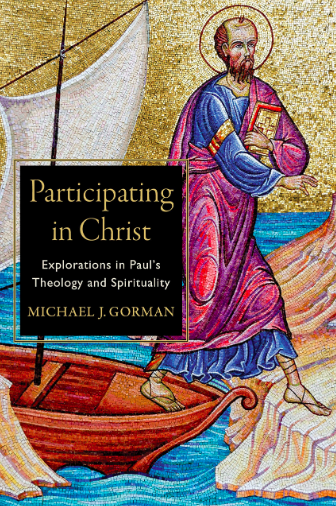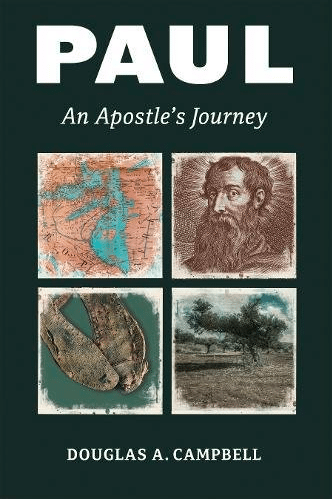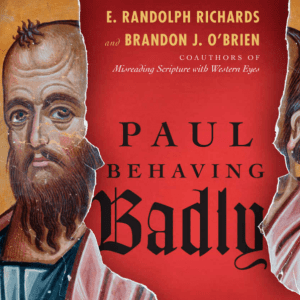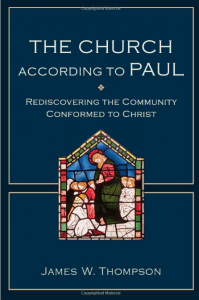 Any good solution to the big problems of life must deal at some point with “why evil?” If the apostle Paul proposed big solutions to life then he had to deal with evil, so N.T. Wright, in Paul and the Faithfulness of God, sketches the various solutions to the problem of evil and then offers how Paul’s “revised monotheism” (around Jesus, around the Spirit [he spells it “spirit”]) deals with evil.
Any good solution to the big problems of life must deal at some point with “why evil?” If the apostle Paul proposed big solutions to life then he had to deal with evil, so N.T. Wright, in Paul and the Faithfulness of God, sketches the various solutions to the problem of evil and then offers how Paul’s “revised monotheism” (around Jesus, around the Spirit [he spells it “spirit”]) deals with evil.
Of the Stoics, Epicureans, and Jewish monotheists, Paul fits with the Jewish monotheists and offers a version of their response to evil, which is sharper than any response one finds among the Stoics of Epicureans.
The monotheism of second-temple Jews generated a more sharply etched idea of evil than we see in the surrounding pagan worldviews, including those of ‘monotheists’ such as the Stoics. Once you offer, and celebrate, an account of creational and covenantal monotheism such as we find in Israel’s scriptures, you are going to run into major problems. If there is one God, if he is the creator of a good world and still basically in charge of it, and if he is in covenant with Israel in particular, then neither the Stoic nor the Epicurean solution will do. Nor is serious dualism an option, though there are times when it will look attractive. If the book of Job had not existed, it would have been necessary to invent it (739-740).
Now a vitally important set of ideas, so bear with the longer quotation from p. 740:
Ancient Israel did not, however, attempt a ‘solution’ in terms of a coherent analysis of why evil existed within the good creation. Job did not ‘solve’ the problem, but, like some of the Psalms, simply and strikingly reaffirmed the basic monotheistic creed – and complained sharply about the way things were. In the Torah, evil might be traced back to Adam and Eve in the garden, though interestingly there is no sign of this being offered as an ultimate analysis prior to the late first century AD. Or evil might have entered the world through the invasion of strange angelic powers, as in Genesis 6. One might also look back to the arrogance of empire, as in the story of the Tower of Babel in Genesis 11. Or, in relation more specifically to evil within Israel, one could lay the blame on the primal sin of Aaron in making the golden calf (Exodus 32).
These ‘solutions’ were not, of course, mutually exclusive. That was not how ancient Jews read their scriptures. The various accounts of evil functioned, not as scientific ‘explanations’, but as signposts to dark and puzzling realities. Human rebellion, idolatry and arrogance, mingled with shadowy forces from beyond the present world, had infected the world, humans and Israel itself. The narratives drew attention to different apparent elements within the problem, and left it at that. No solution was offered to the question of what modern philosophers have called ‘natural evil’ (earth- quakes, sickness and the like). Prophets might highlight particular events as warning signs from the One God – a line of thought echoed at one point by Paul – but nobody, not even Job, seems to have asked why such things existed at all within a good creation. The occasional prophetic promise of a transformed creation bore witness to the fact that some at least had an inkling that the trouble ran right through the cosmos itself; but the offer of an eschatological solution was not matched by an analysis of why a problem existed in the first place.
But if scripture offered no ‘solution’ in terms of a coherent account of why ‘evil’ existed in the good creation, it offered instead a ‘solution’ in terms of what was to be done – specifically, what was to be done by the creator God. The major proposal was first covenantal and then eschatological: not ‘where did evil come from?’but ‘what will the creator God do about it?’
And from p. 742 another important insight: “The fact that one cannot really understand evil is itself an element of creational monotheism, a demonstration that evil is an intruder…”.
Put the argument thus far into logical outline and this (from p. 746) is what you get:
My point thus far can be summarized like this:
- All views about ‘evil’ are the correlate of a basic, and often theistic, worldview;
- All worldviews, except those of the most shallow and unreflective optimist, have some idea that something is seriously wrong with the world, and indeed with human beings, often including one’s own self;
- Monotheists in particular run into a problem which polytheists do not have, and there have been various ways, historically, of addressing that problem;
- Monotheists of the second-temple Jewish variety, that is, creational and covenantal monotheists, were bound to have a particularly sharp version of the wider monotheistic problem:
- (a) the world is God’s creation, and yet there is evil in it;
- (b) humans are in God’s image, and yet they rebel;
- (c) Israel is called to be God’s covenant people, and yet is troddendown by the nations.
- This was addressed
- (a) by varied use of the ancient narratives of Genesis and Exodus;
- (b) by cultic monotheism (especially the sacrificial system); and
- (c) by eschatological monotheism (the hope and promise that oneday YHWH would return, would unveil his covenant faithfulness in rescuing his people and renewing all things, and would set up his sovereign rule over the whole world).
Now from p. 747: “My proposal, then, is that Paul’s radical rethinking of creational and covenantal monotheism contained within itself both an intensification of the problem and an equally radical solution.”
In Wright’s resolution of these issues he begins by sketching the widespread Augustinian assumption (plight to solution) and its challenge by Sanders and Barth (solution to plight), while he wants to broaden it all to the problem of evil instead of just the problem of personal sin and salvation (and he repeats the well-worn but important new perspective view that Jews were not seeking heaven-when-we-die solutions). Wright thinks there was a plight problem, that the solution came in Christ, but that the solution redefined the original plight in more expansive terms.
What then was the reimagined plight? How did Paul’s grasp of ‘the solution’ enable him – or, indeed, compel him – to radicalize the original ‘plight’ which we have set out in the previous section? We can sketch this in three quick moves which we will then substantiate exegetically. The cross, the resurrection and the holy spirit together brought the ‘plight’ suddenly and sharply into focus.
- The most obvious element of Paul’s revised version of the ‘plight’ follows directly from the fact of acrucified Messiah. ‘If “righteousness” comes through the law, then the Messiah died for nothing.’ That is basic to everything else.
- Not so obvious, but equally important, was the fact of the risen Messiah. Paul’s understanding of the resurrection gave him a much more focused understanding of the creator’s purposes for the whole cosmos – and hence of the problem, the ‘plight’, in which that whole creation had languished.
- The revelation of the personal presence of Israel’s God in the trans- forming work of the spirit compelled Paul to a recognition of the depth of the human plight. All humans, Jews included, were hard- hearted, in need of renewal in the innermost human depths (750).











